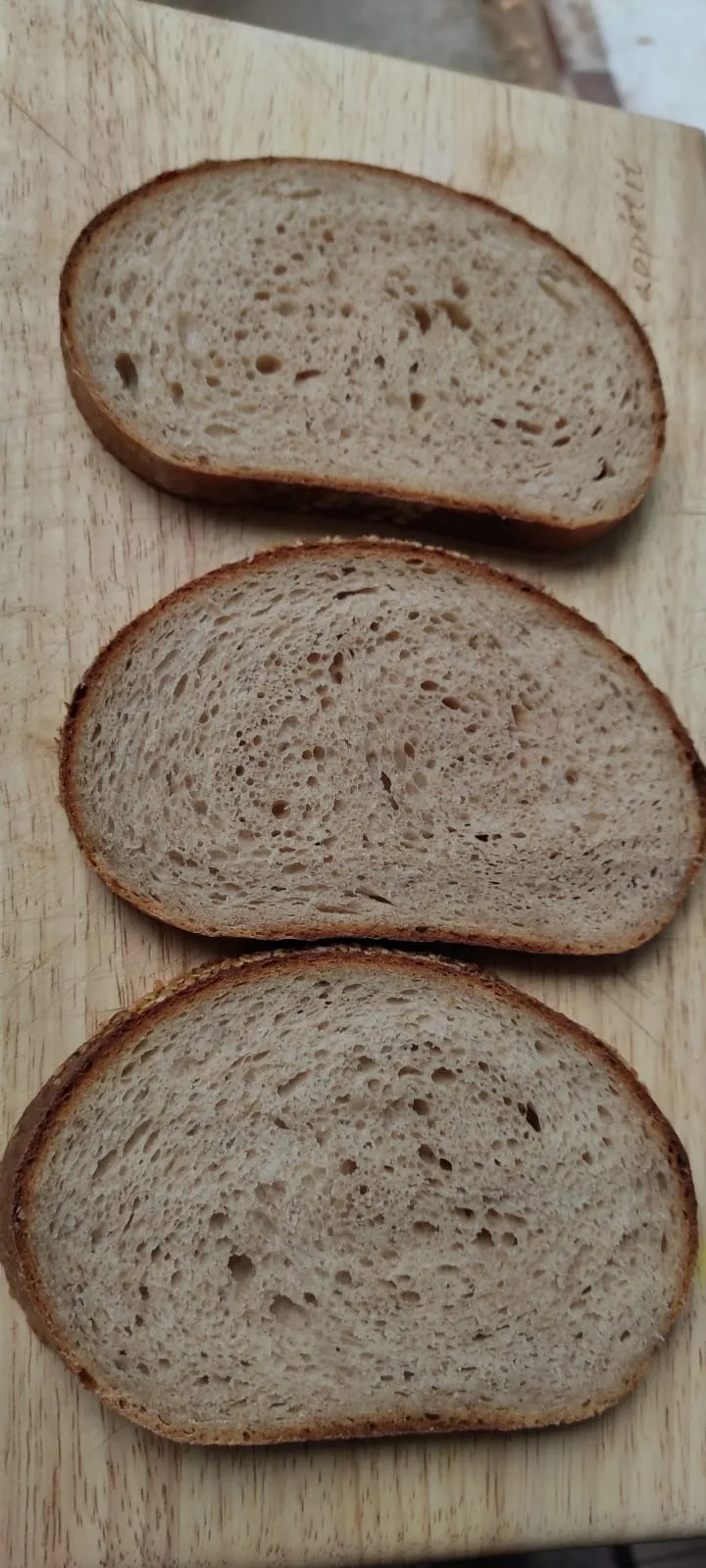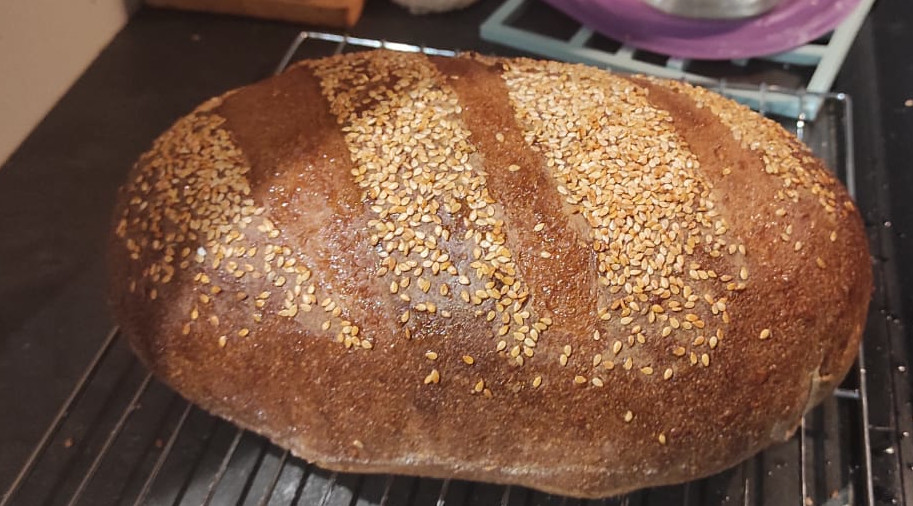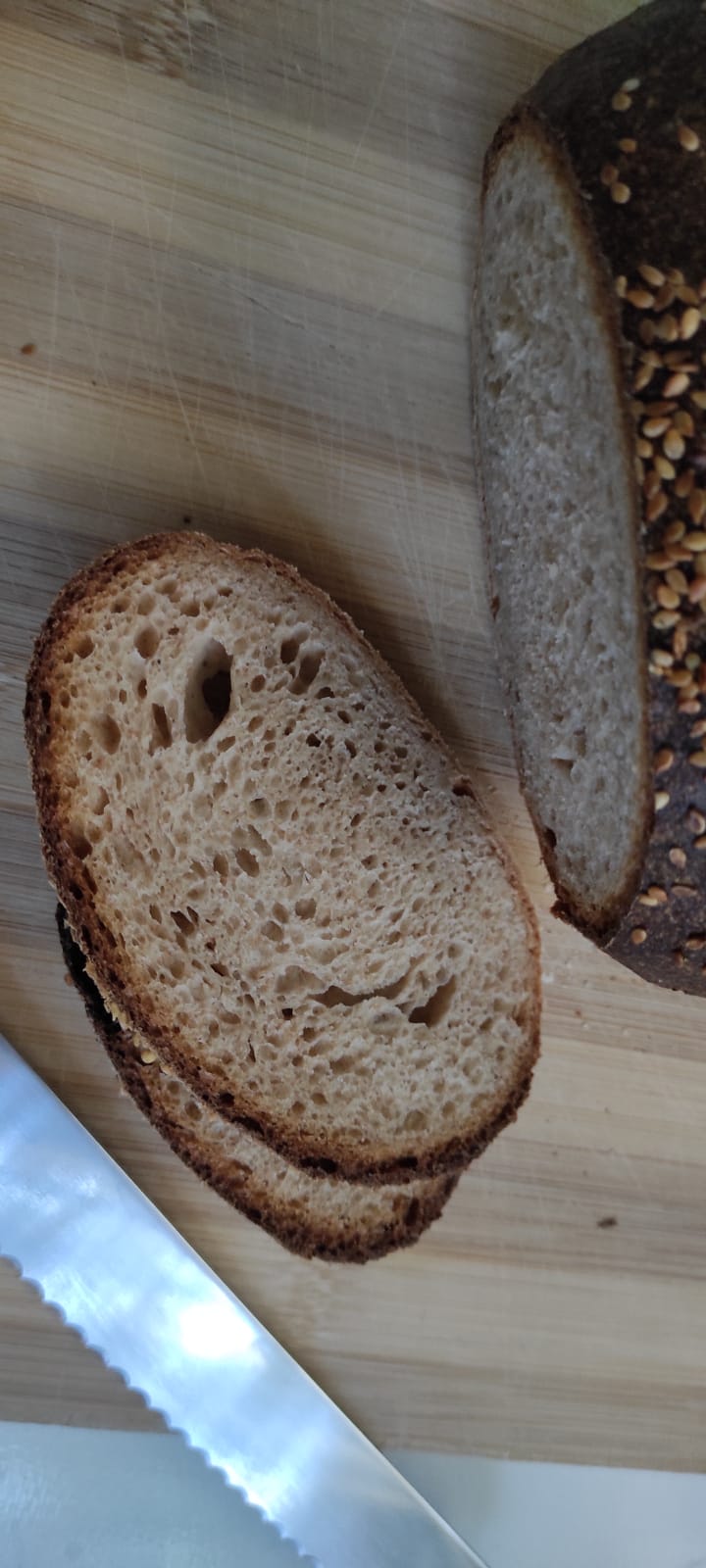
David Snyder has previously posted a magnificent recipe for a Buttermilk-Spelt sourdough bread (originally by Cecilia Agni Hadiyanto). This is a tweak of David's recipe to accommodate a large preferment, mostly because I've lately been wanting shorter bulk and proof times on my breads. Since my sourdough starter hadn't been fed for a week in the fridge when I did this one, I also added in a yeast water preferment as an insurance that the bread would rise.

Both preferments were used when they were 8.5 hours old. The formula adjustments that I needed to make to the recipe meant that I used less buttermilk than David did (in order to feed the sourdough preferment with water rather than buttermilk).
Unusually, the sourdough levain had great bubble development and was already 'pourable' after 8.5 hours old whereas the apple yeast water build looked fairly young with poorer bubble development. Probably this was because the apple yeast water from the fridge wasn't as active as the visual fizz seemed to suggest.
I've had a few problems in the past with spelt overextending and spreading, even turning into a dough 'soup', so was a little extra cautious, I added in 10g of VWG to be increase the chance of success, and actually ended up using 30g less of the buttermilk than I intended because I had held some back.
Even so, there were a few minutes when I was watching the mixer worrying that it wouldn't come together, but after 8 minutes on the dough hook it started to look like it would clean the bowl and the salt was added only at that point which tightened the gluten noticeably. I gave it 9.5 minutes on the dough hook in total and tried to do good gluten development upfront because of the speedy ferment.
This bread had 2 hours of bulk ferment at 27°C/80°F (with a single fairly tight fold about halfway through), and a further 40 minutes for final proof (on the wine-bottle couche) before immediately baking. The aliquot jar showed around 55% volume increase at the time of shaping and 105% when it went into the oven, where I baked on a baking steel.
The bread came out quite dark, even though I only baked it for 38 minutes. There was nice oven spring and an even crumb.


David is right, this bread makes for exceptional eating and I can see myself making it again and again. The buttermilk made it a bit sour and the ~40% wholemeal spelt (a bit lower in this version) gave it a bit of nuttiness. In fact, it tasted a lot like a rye. My personal jury is out if I prefer it over Caroline's holy trio of Olive-oil/buttermilk/honey which tastes just a wee bit similar, although sweeter, so I guess I'll have to repeat this exercise again but with some olive oil and honey!
- JonJ's Blog
- Log in or register to post comments
Beautiful loaf Jon, it seems like we both have had spelt on our minds and in our bread recently. Love the even crumb and beautiful oven spring. I still haven’t tried buttermilk as I never have a use for it so just don’t buy it. Whenever I’ve needed it in a recipe, say a buttermilk quick bread, I’ve always just added vinegar to milk which is close but not the same thing. Anyhow, that is a good looking loaf.
Benny
Ben Starr has a lot to say about real buttermilk. Trying to culture my own based on what he had to say.
Thanks for the link on buttermilk...I had no idea you could continually perpetuate ongoing buttermilk, essentially a starter from the original batch. Interesting! I may have to give this a try soon. Another option is in the info I provided above below (oops) in reply to Benny about buttermilk powder, which is a super convenient way to keep it on hand as well.
That was a great read about an ingredient I’ve never used, thanks for sharing that with me Jon. Now I think I actually need to try some real buttermilk for the first time in my life.
Benny
He says infinite culturing from one container but it’s kind of like plain yogurt, you can make more from the batches you make but after a bit you need to start with a new container.
The Bulgarian is the very best it has both buttermilk and yogurt cultures and tastes fantastic! He is also correct in that buttermilk keeps for months and doesn’t go bad by the date on the container. Anything you make that calls for regular milk tastes better with buttermilk 😊 I make Mac n cheese pretty regularly and it’s amazing made with buttermilk. Cakes are all better with buttermilk as are mashed potatoes as he suggests. Also roast sweet potatoes and take them out of their skins and mash with buttermilk and a pinch of salt and a sprinkle of cinnamon! It’s delicious. All creamed soups as well especially butternut squash. You can freeze it in one cup portions. Make biscuits and for sure cornbread. We use 1/2 gallon at least every month!
He says infinite culturing from one container but it’s kind of like plain yogurt, you can make more from the batches you make but after a bit you need to start with a new container.
The Bulgarian is the very best it has both buttermilk and yogurt cultures and tastes fantastic! He is also correct in that buttermilk keeps for months and doesn’t go bad by the date on the container. Anything you make that calls for regular milk tastes better with buttermilk 😊 I make Mac n cheese pretty regularly and it’s amazing made with buttermilk. Cakes are all better with buttermilk as are mashed potatoes as he suggests. Also roast sweet potatoes and take them out of their skins and mash with buttermilk and a pinch of salt and a sprinkle of cinnamon! It’s delicious. All creamed soups as well especially butternut squash. You can freeze it in one cup portions. Make biscuits and for sure cornbread. We use 1/2 gallon at least every month!
I will have to try the homemade buttermilk recipe. Then I could have unsalted buttermilk for recipes. I have used a similar method that works really well to make crème fraîche from sour cream and heavy cream. I also wonder if using dilute lactic acid instead of vinegar to acidify milk would yield a better approximation for buttermilk in a pinch. I have lactic acid from a brewing store that I bought to make a lactart soda (it was a competitor of acid phosphate sodas, a popular old-time fountain drink).
I have used the SACO brand buttermilk powder and it seems to give good results in yeasted breads that call for buttermilk. I don’t make many quick breads so I haven’t used it for that purpose, yet. It does contain two other ingredients other than cultured buttermilk: sweet dairy whey and lactic acid; those are essentially what would be in buttermilk anyway. I also like it because it doesn’t have any added salt like commercial buttermilk, so I don’t have to account for the additional salt that it contributes. (I know milk already has sodium in it, but it is balanced by a hefty amount of potassium.) I also have seen kefir mentioned as a substitute for buttermilk and I actually prefer kefir over buttermilk for drinking straight.
Hey Benny! I've successfully swapped plain yogurt (not the thick, Greek kind) into baking recipes very successfully when it has called for buttermilk and I didn't have any fresh. Also, a kitchen staple I stumbled across a few years ago and now am never without is organic buttermilk powder. There is also a fairly popular non-organic brand, but it has other ingredients in it besides just buttermilk. I keep the powder in a glass jar in the fridge and it lasts forever. A tablespoon each of the powder and water makes a very close approximation to the real thing albeit a tad runnier. I use it fairly often in baked goods, not just bread...it's a great product. It eliminates the need to buy a single ingredient that I only need a little of. It helps make some lovely sourdough discard pancakes too!
That’s good to know, I’ve never heard of this powder before. It sounds like I could make buttermilk with a bit of planning though. I sometimes have sour cream and it seems like I could use that to inoculate some milk and make buttermilk unless my quick read of the information on buttermilk was incorrect. Thanks for the information Leigh.
Benny
Hewitt buttermilk (no mouthfeel additives I believe) is available in TO. Probably pricier at Big Carrot on Danforth. Cheaper at Starsky, the Polish market in Mississauga (at least when I was there a few years ago)
https://www.hewittsdairy.com/products/specialty-milk-products/buttermilk
Bulkbarn has buttermilk powder. I used it in yeast based croissants before I switched to sourdough.
Thanks for sharing that David, never thought to look at Bulk Barn, which I go to frequently, for the powder. I’ll check the stores nearby to see what buttermilk they carry.
It does work in a pinch, often has added lactic acid and other additives. Bob's Red Mill makes one that is *just* dried buttermilk. (I read a LOT of labels)
King Arthur Baking also sells a 100% buttermilk powder. However, in a KA blog on buttermilk substitutes, a KA employee mentioned that further testing of their buttermilk powder showed that it did not provide the same level of acidity as lemon juice or vinegar + milk, or Greek yogurt thinned with water. I don't know if the BRM powder has the same acidity level.
None of my attempts at buttermilk recipes (biscuits, pancakes) were working until I realized I was using imitation buttermilk that had various gums in it, locust bean gum, carrageenan, etc. The gummy buttermilk, both low fat and full fat, is all that my Kroger carries.
Previous thread on buttermilk:
https://www.thefreshloaf.com/node/69256/fake-vs-real-buttermilk
That looks like a perfect sandwich loaf in my estimation and sounds like it has an interesting flavor profile. Would you omit the yeast water (making adjustments for fluids of course) if you have an active starter?
You mentioned honey. I'm finding that I prefer the addition of honey to any of my bakes that incorporate a good portion of whole wheat. I think it helps smooth out any subtle sharpness that whole grains can sometimes add.
Excellent post...thanks for sharing!
Hi Leigh, yes, no problem omitting the yeast water and in fact David's original recipe with just the sourdough starter is lovely as it is. I've just tweaked everything to be fast in my version of it.
I find what Caroline has to say about honey in the comment below very interesting.
-Jon
I have made David's formula a couple times and I love it. You can substitute yogurt for the buttermilk anytime you feel like a change and the bread still comes out very moist and delicious. I made the Kernsa bread the other day and only added 30g each of honey .EVOO and yogurt to 2400g of dough, I wish I had added more as I did in my other loaf that you referenced as there is a very big difference in the incredible moistness that the bread maintains for days and days after baking. Honey stops bacteria and I think that is why the bread stays so fresh. I will be upping the amounts when I next make the Kernsa bread and will up it in David's as well. Your bread is beautiful ! c
Thanks. I did make a Ben/Eric rye with your holy trio the other day (but didn't post about it here). What an amazing combination - thank you - and that was 75g of each of the trio in a regular sized loaf. Brought the loaf over to celebrate new years and it was gone so fast that I felt I didn't taste it properly.
My wife did an ayurvedic course years ago where they tell you that cooked honey is bad for you, so I always have to overcome that belief before using it in my bakes.
-Jon
I used that much, 75g 0f each , in a 3000g batch LOL !! You definitely have experimented and found a worthy method for your bread. I will be adding it to more until I get tired of it :) c
Embarrassingly it was then an 'accidental' experiment as I misunderstood your post and had about triple the quantities! Miraculously it made a fine bread. Did have to drop the water down significantly after adding 75g of each ingredient for anyone who wants to repeat the holy trio miracle. My notes say 314g rye sour, 96g of water, 75g olive oil, 75g honey, 75g buttermilk, 384g bread flour (11.4% protein though), 10g VWG (drop this if using a stronger flour), 0.5tsp instant yeast, no sugar, 11g salt, made using Benny's method. It did bake dark with that much honey.
So much interesting info in this thread today! Buttermilk or yogurt, honey and now the holy trio ;-). I'm curious about using them all together...I've made lots of things with each of the ingredients but not usually all three together. I often sub out some of the butter in sweet bakes with some yogurt or olive oil, which provides a lot of moisture, so I can see it working well for bread too. Itching to give this a try now!
As far as the honey in bread, from what I understand, it is actually preferred to use pasteurized or heated honey because there are enzymes in raw honey that can alter the dough detrimentally. For other uses, like for toppings on fruit, toast or yogurt, raw, unpasteurized and unfiltered honey is reported to have better health benefits. It would be difficult to use the raw/unpasteurized/unfiltered version in baking anyway because it is thick like peanut butter--delicious but slightly more difficult to incorporate well into a bread dough I would think. So, I usually keep some of the pasteurized/squeezable kind on hand for use in bread dough.
In equal parts and just sub that volume for some of the water. I use 25g of each per 1000g loaf. So it’s 75g less liquid usually water when I am weighing out my ingredients.
As far as raw unpasteurized honey adversely affecting the bread that has never been the case. I have never used any other kind of honey and it’s definitely pourable . I go to the beekeepers’s house and he spins it out of the comb and pours it into the qt jars for me. No treatments are used on the honey.
I have baked with honey in my breads and other baked goods since the 70’s and never had any problems. The amounts I am using of each ingredient are so small vs the other ingredients you will be amazed at how tender and delicious the whole grain breads become. The dough is so velvety and the baked breads are so tender and stay fresh for days. I never sift my flour and I use my Mock Mill to grind all my grains.
I think you will be pleasantly surprised by the results. I usually scale all my loaves to 1000g size because I have found they generate enough moisture when baked in my graniteware roaster that I don’t need any mechanism for other steam. I bake covered 15 min at 475 then uncovered at 450 for 30-35 min. The loaves are always 205 F or so when finished.
Have a go at it with one loaf. 🙏
Looks absolutely delicious.
Well done. I love the shape and the crumb is so uniform.